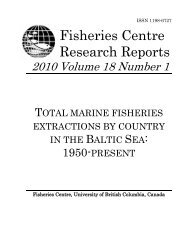Trends in GlobAl MArine Fisheries - Sea Around Us Project
Trends in GlobAl MArine Fisheries - Sea Around Us Project
Trends in GlobAl MArine Fisheries - Sea Around Us Project
You also want an ePaper? Increase the reach of your titles
YUMPU automatically turns print PDFs into web optimized ePapers that Google loves.
Figure 9. Paired Stock-Catch-Status Plots for all LMEs <strong>in</strong> the world<br />
comb<strong>in</strong>ed, where<strong>in</strong> the status of stocks, i.e., species with a time<br />
series of land<strong>in</strong>gs <strong>in</strong> an LME, is assessed us<strong>in</strong>g the follow<strong>in</strong>g<br />
criteria (all referr<strong>in</strong>g to the maximum catch <strong>in</strong> the species time<br />
series): Develop<strong>in</strong>g (catches < 50 %); Fully exploited (catches<br />
> = 50 %); Overexploited (catches between 50 % and 10 %);<br />
Collapsed (catches < 10 %).<br />
Top: Percentage of stocks of a given status, by year, show<strong>in</strong>g<br />
a rapid <strong>in</strong>crease of the number of overexploited and collapsed<br />
stocks.<br />
Bottom: Percentage of catches extracted from stocks of a<br />
given status, by year, show<strong>in</strong>g a slower <strong>in</strong>crease of the percentage<br />
of catches that orig<strong>in</strong>ate from overexploited and collapsed<br />
stocks. Note that ‘stocks’, i.e. <strong>in</strong>dividual land<strong>in</strong>gs time series, only<br />
<strong>in</strong>clude taxonomic entities at species, genus or family level, i.e.<br />
higher and pooled groups have been excluded.<br />
Figure 10. Stock-Catch Status Plots for the Newfoundland-<br />
Labrador Shelf LME, show<strong>in</strong>g the proportion of develop<strong>in</strong>g<br />
(green), fully exploited (yellow), overexploited (orange) and collapsed<br />
(purple) fisheries by number of stocks (top) and by catch<br />
biomass (bottom) from 1950 to 2004.<br />
Note that (n), the number of ‘stocks’, i.e. <strong>in</strong>dividual land<strong>in</strong>gs<br />
time series, only <strong>in</strong>clude taxonomic entities at species, genus or<br />
family level, i.e. higher and pooled groups have been excluded<br />
(see Pauly et al. <strong>in</strong> press for def<strong>in</strong>itions).<br />
<strong>Trends</strong> <strong>in</strong> global mar<strong>in</strong>e fisheries – a critical view<br />
Number of stocks by status (%)<br />
Number of stocks by status (%) Catch by stock status (%)<br />
Catch by stock status (%)<br />
Develop<strong>in</strong>g Fully exploited Over-exploited Collapsed<br />
Develop<strong>in</strong>g Fully exploited Over-exploited<br />
(n=2341)<br />
Collapsed<br />
(n=2341)<br />
71





![Nacion.com, San José, Costa Rica [Nacionales] - Sea Around Us ...](https://img.yumpu.com/26166123/1/190x245/nacioncom-san-josac-costa-rica-nacionales-sea-around-us-.jpg?quality=85)










